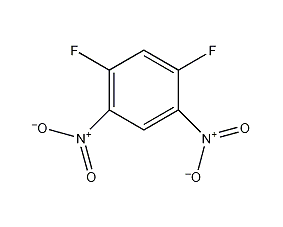1,5-difluoro-2,4-dinitrobenzene


Structural formula
| Business number | 0480 |
|---|---|
| Molecular formula | C6H2F2N2O4 |
| Molecular weight | 204.09 |
| label |
1,5-difluoro-2,4-dinitrobenzene, 1,3-difluoro-4,6-dinitrobenzene, 1,5-Difluoro-2,4-dinitrobenzene (discontinued), 1,5-DIFLUORO-2,4-DINITROBENZENE, 1,5-DINITRO-2,4-DIFLUOROBENZENE, 1,3-DIFLUORO-4,6-DINITROBENZENE, DFDNB, LABOTEST-BB LT00159520, 2,4-Dinitro-1,5-difluorobenzene, 2,6-dinitro-3,5-difluorobenzene, 4,6-Difluoro-1,3-dinitrobenzene |
Numbering system
CAS number:327-92-4
MDL number:MFCD00007052
EINECS number:206-324-0
RTECS number:CZ5663200
BRN number:1883116
PubChem ID:None
Physical property data
一 , physical property data
Traits :Crystal
Density (g/mL,25/4℃): Not available
Relative Vapor density (g/mL, air=1):Not available
Melting point (ºC): 72-74
Boiling point (ºC , normal pressure):Not available
Boiling point (ºC, 5.2kPa): Not available
Refraction Rate: Not available
Flash Point (ºC): Not available
Optical rotation (º): Not available
Spontaneous combustion Point or ignition temperature (ºC): Not available
Steam Pressure (kPa, 25ºC): Not available
saturated Vapor pressure (kPa, 60ºC): Not available
Burn Heat (KJ/mol):Not available
Critical Temperature (ºC): Not available
Critical Pressure (KPa): Not available
oil and water Log value of the (octanol/water) partition coefficient:Not available
Explosion Upper limit (%, V/V): Not available
Explosion Lower limit (%, V/V): Not available
Dissolve Properties: Not available
Toxicological data
Two , Toxicological data:
Acute Toxicity:Not available .
Ecological data
Three , Ecological data:
1 ,Other harmful effects: This substance may be harmful to the environment, and special treatment should be given to water bodies. Notice.
Molecular structure data
1. Molar refractive index: 39.33
2. Molar volume (m3/mol):121.5
3. isotonic specific volume (90.2K):332.4
4.  >
Dissolve Properties: Not available
Toxicological data
Two , Toxicological data:
Acute Toxicity:Not available .
Ecological data
Three , Ecological data:
1 ,Other harmful effects: This substance may be harmful to the environment, and special treatment should be given to water bodies. Notice.
Molecular structure data
1. Molar refractive index: 39.33
2. Molar volume (m3/mol):121.5
3. isotonic specific volume (90.2K):332.4
4. Surface Tension (dyne/cm):56.0
5. Polarizability(10-24cm3):15.59
Compute chemical data
1. Reference value for hydrophobic parameter calculation (XlogP): 1.8
2. Number of hydrogen bond donors: 0
3. Number of hydrogen bond acceptors: 6
4. Number of rotatable chemical bonds: 0
5. Number of tautomers: none
6. Topological molecule polar surface area 91.6
7. Number of heavy atoms: 14
8. Surface charge: 0
9. Complexity: 227
10. Number of isotope atoms: 0
11. Determine the number of atomic stereocenters: 0
12. Uncertain number of atomic stereocenters: 0
13. Determine the number of chemical bond stereocenters: 0
14. Number of uncertain chemical bond stereocenters: 0
15. Number of covalent bond units: 1
Properties and stability
None yet
Storage method
None yet
Synthesis method
None yet
Purpose
None yet
; Surface tension (dyne/cm):56.0
5. Polarizability(10-24cm3):15.59
Compute chemical data
1. Reference value for hydrophobic parameter calculation (XlogP): 1.8
2. Number of hydrogen bond donors: 0
3. Number of hydrogen bond acceptors: 6
4. Number of rotatable chemical bonds: 0
5. Number of tautomers: none
6. Topological molecule polar surface area 91.6
7. Number of heavy atoms: 14
8. Surface charge: 0
9. Complexity: 227
10. Number of isotope atoms: 0
11. Determine the number of atomic stereocenters: 0
12. Uncertain number of atomic stereocenters: 0
13. Determine the number of chemical bond stereocenters: 0
14. Number of uncertain chemical bond stereocenters: 0
15. Number of covalent bond units: 1
Properties and stability
None yet
Storage method
None yet
Synthesis method
None yet
Purpose
None yet
















